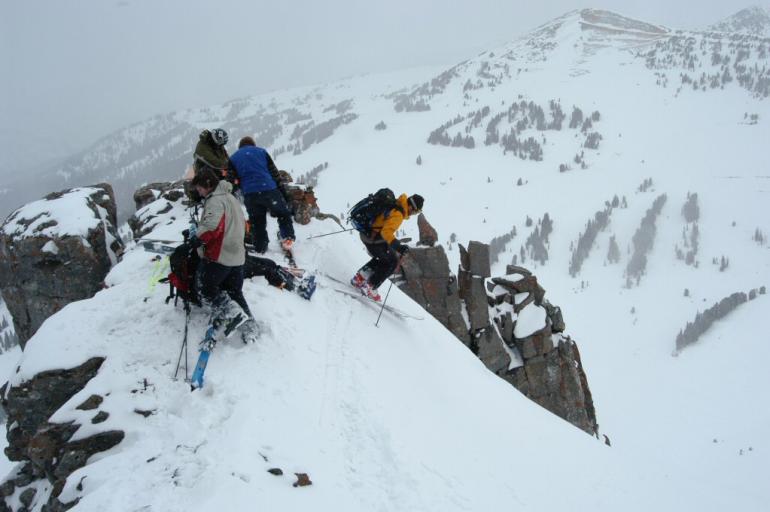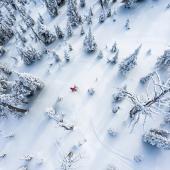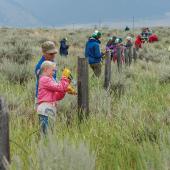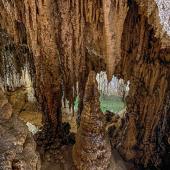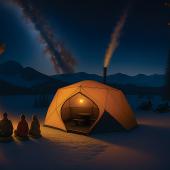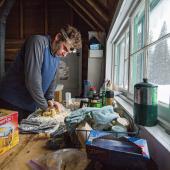A Powder-Skiing Gold Mine
Aka, the Beartooths.
Cooke City is nestled near the northeast corner of Yellowstone National Park and isolated from eastern access much of the year by the rugged Beartooth Mountains. A virtual dead end in winter months, Cooke City’s residents say the year-round population is just under 100 these days, but that statement is generally followed by a whisper, "not counting those without Social Security numbers."
An unincorporated town, Cooke City has no law to speak of, aside from two cop cars resting on either shoulder of Highway 212 with four flat tires and permanently empty front seats. Just before winter, the cruisers are towed to safety, away from the crushing weight of the nearly 400 inches of snowfall the town will receive.
In 1988, an all-consuming, untamable Yellowstone National Park fire nearly devastated this little Rocky Mountain town. Fire spread over some 990,000 acres in the Park and close to 420,000 acres of surrounding national forest, including parts of the North Absaroka, Teton, and Absaroka-Beartooth Wilderness. In Cooke City, the fire back-burned every standing and fallen tree right up to structures on the north side of town.
When the Beartooth Highway closes in early fall, Cooke City takes a deep breath from the hordes of summer Yellowstone visitors and Beartooth Highway bikers to quietly await the snow. When winter bears down, summer residences are buried and any sign of pavement disappears for the next five to six months.
The closest developed town, Livingston, is some two hours away and for most residents of Cooke City, trips to the big city are kept to a minimum. The living is slow and amenities are limited. Each of the residents have their own reason for living in Cooke City, but all have at least two things in common: a tolerance for snowmobiles and a love for dogs.
Dogs give people a run for their money in Cooke City. As lawless as the little town itself, mongrels have free reign of not only the streets, but the businesses as well. The only thing to outnumber dogs may be snowmobiles. At NASCAR proportions on the weekends, snowmobiles mean winter revenue and backcountry skiing in the otherwise inaccessible Beartooths. Most locals will tell you to either use them or deal with them.
Here’s the beauty of Cooke City. Everything north of town is shared with snowmobile traffic, meaning it’s all easily accessible by machine. But everything south of town is wilderness—no motorized vehicles allowed—so every foot of elevation has to be gained the old-fashioned way.
Faced with the choice of riding into the higher elevations, or climbing, most people ride, leaving the south side of town untouched much of the year. Either way, you can get plenty of distance from the snowmobiles; it just takes a little effort. There are tons of places to go and more wilderness than anything else.
A small cult following has developed for skiing in the area and each year they come in small droves throughout the winter and spring. One weekend of the year, the annual Sweet Corn Festival, they come en masse. Although this year should be the 10th Annual event, no one is quite sure if it will actually take place. Sweet Corn occurs the weekend following Easter, but only if the locals feel motivated enough to put it on. If the town does pull it off, there are skiers, snowboarders, and dogs strung out from town to Daisy Pass, a favorite ski haunt north of Cooke City.
Bill Blackford, owner and operator of the Cooke City Bike Shack, has been living in Cooke City for twelve years. His shop doubles as a coffee and espresso house, as well as a backcountry shuttle and guide service in the winter. Blackford offers one-way passage into the Absaroka-Beartooth wilderness for $15 to $30 per person. Your other option is to take the heel-toe express uphill south of town.
Daisy Pass is five miles or a 30-minute snowmobile trek up and can take anywhere from one hour to a full day to descend. For most people, the day is spent working the mountains, hiking and skiing until the sun threatens to slide behind the jagged mountain peaks. When the day is done, skiers surface on a north-facing, burned-out slope called Town Hill, and ski clear through town to the Cooke City Bike Shack’s door.
Blackford will take passengers as far as the Goose Lake Jeep Trail, twelve miles into the Beartooth Mountains. The snowmobile ride takes an hour and fifteen minutes, "depending on the dogs." Being Cooke City, no worthy mongrel is left behind and if they won’t ride on the machine, they must run behind.
"This one dog, Wolfy, is a big huge husky-type dog who will not get on or near a snowmobile," says Blackford. "With Wolfy, it always takes twice as long to get anywhere. I usually don’t charge extra for dogs, unless they are sluggishly slow. I really should start charging an extra five bucks for Wolfy."
The day I went to Cooke City, the choice was simple...I paid for a ride up to Daisy Pass. Having never skied the area, I hired one of Blackford’s guides. Guides are highly suggested if you have never skied in the Cooke City/Beartooth area. Avalanches are common and the terrain is varied and unpredictable. With a good portion of the area surrounding town back-burned from the 1988 fires, the terrain looks the same from any direction. Unfamiliar skiers can find themselves easily lost and in uncompromising spots. If that were to happen, who would come looking for you? Most likely, no one. Twenty community members comprise the Cooke City Search and Rescue and proudly claim they have yet to lose a skier. But then again, how would they know you were lost?
Guides range from a half-day backcountry tour for $45 per person to a full-day tour deep in the Beartooths for $95 per person. The guide service includes a ride to the destination and guided trip down. On the descent, the guide will point out various options for getting back to town and terrain that should be avoided. The idea being, after going with a guide once, you should be able to go it alone the second time.
Blackford runs seven snowmobiles, or better yet, chariots. Large sleds are pulled by a snowmobile, capable of carrying as many as five people at a time. A large tarp is attached to the rear of the snowmobile, blocking most of the fumes and snow spray put off by the machine. To be honest, the ride was extremely comfortable.
After reaching Daisy Pass, Blackford bid us a good day and sped off. We were left to scan the area and decide which peak to climb. The clear memory of having been towed up five miles made the impending hike much less daunting. By the time we reached the ridge, we were out of sight and earshot of all snowmobiles. Dropping off a razor-thin ledge, we broke fresh tracks down a face too steep to stop. Once to the bowl, we took a necessary breather. Our guide took this time to point out various decent options while I tried to regain muscle composure in my legs. The snow was so deep each turn was made with extreme, yet glorious, effort. Each movement shot a fresh wave of powder over our heads and to stop would have meant sinking dangerously far into the powder. After what felt like an hour of bowl skiing, we took another break overlooking the back-burn near town.
Skiing the burn was by far the best tree skiing I have ever done. Tall, naked trees stood like skeletons against the white snow and multiple lines of descent were clearly visible. After swallowing a good dose of courage we made our way down, hooting and hollering the entire way.
It was just over an hour since we had been delivered to Daisy Pass and we now stood at the top of Town Hill, overlooking Cooke City. The burn led out to Highway 212 and we skied right to the doorstep of the Miner Bar for a little grub, a few beverages, and a quick game of air hockey.
As I mentioned, once we hiked back into the Absarokas a little bit, we were free from snowmobiles. But if you would prefer the entire day away from the NASCAR circuit, go south of town and take the ascent into your own hands—or better yet, legs. The runs are clear from the front porch of the Bike Shack. Most notable are Republic Mountain’s Fin, the Shoulder, and Too Tight To Tele. But no one has skied all there is to ski south of town, and most likely never will. There are several lifetimes worth of ski runs and it would be a lifetime well spent taking on that onus.
Reservations for rides into the backcountry are suggested, but sometimes not appreciated. "If I have the choice, I may be out skiing," says Blackford with a wry grin. "I don’t live here to work, you know." Either way, Blackford takes walk-ins or reservations—what he doesn’t take are late people. Be on time or miss your ride. One last word to the wise, contact the Gallatin NF Avalanche Center before heading out. Better to be safe than sorry, and no one should be sorry after skiing the Beartooths.
Editor's note: Bill Blackford has left Cooke City and the Cooke City Bike Shack no longer exists.

